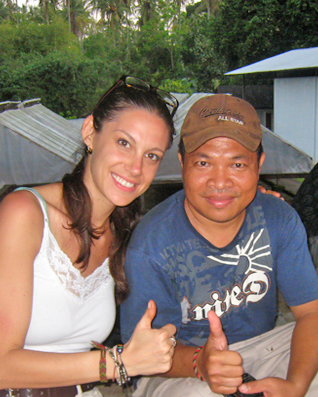

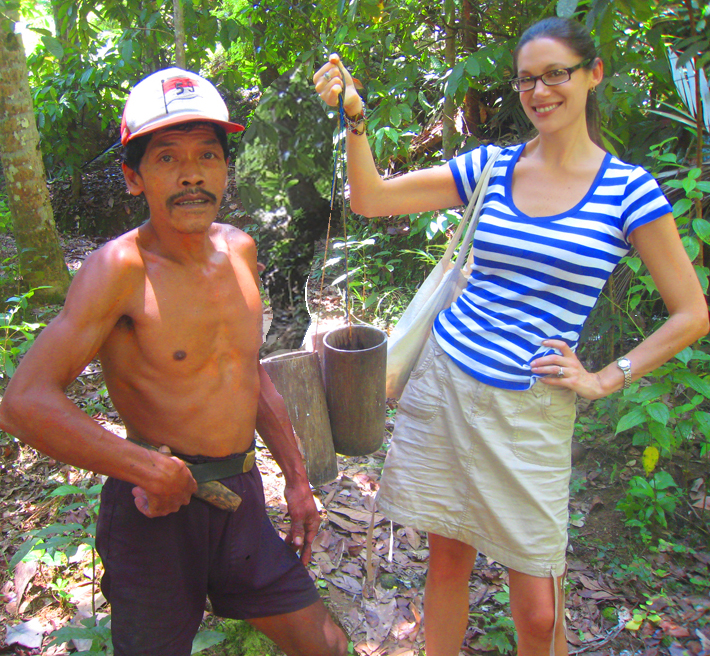
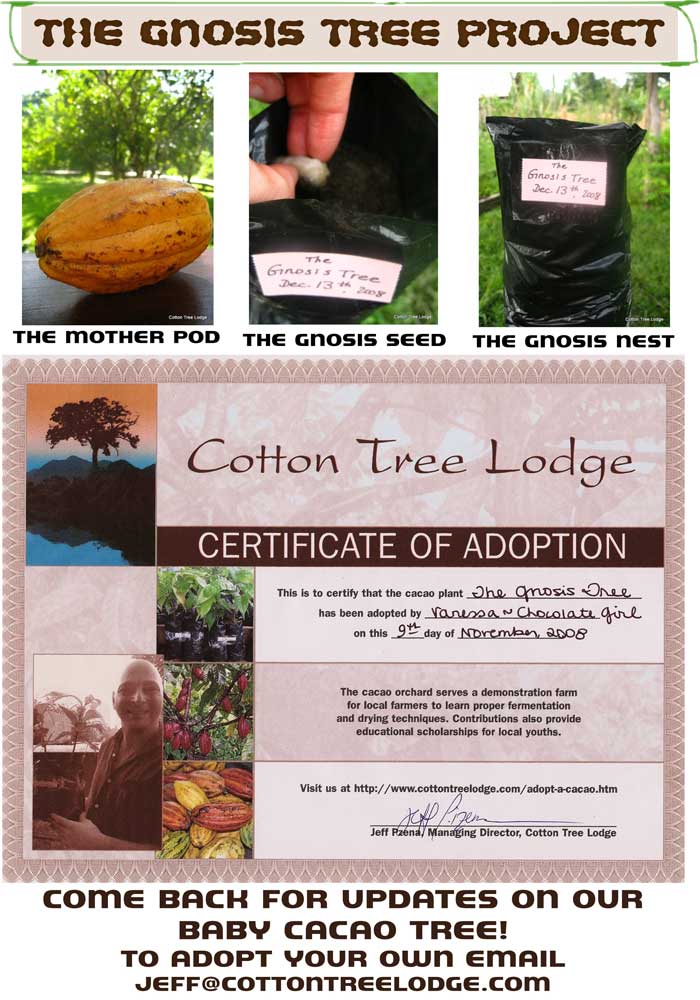

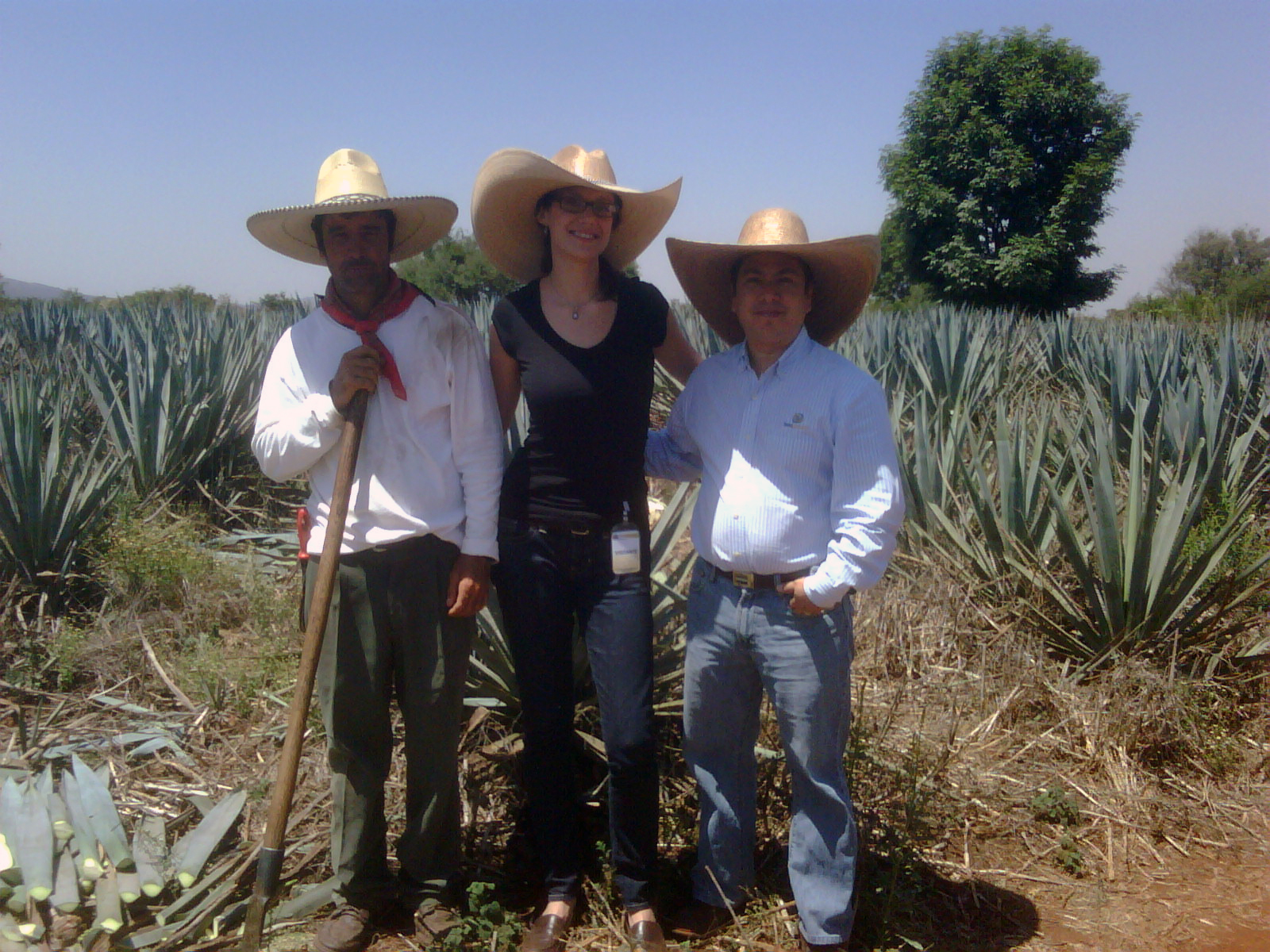
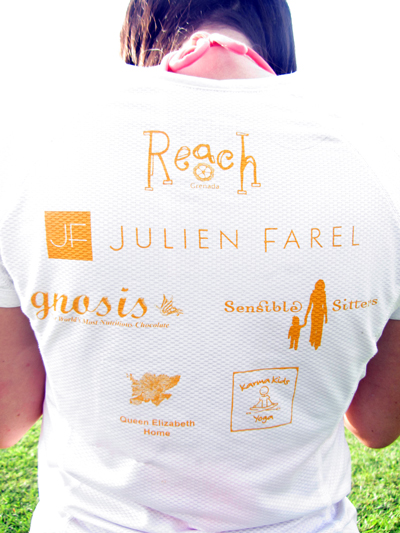


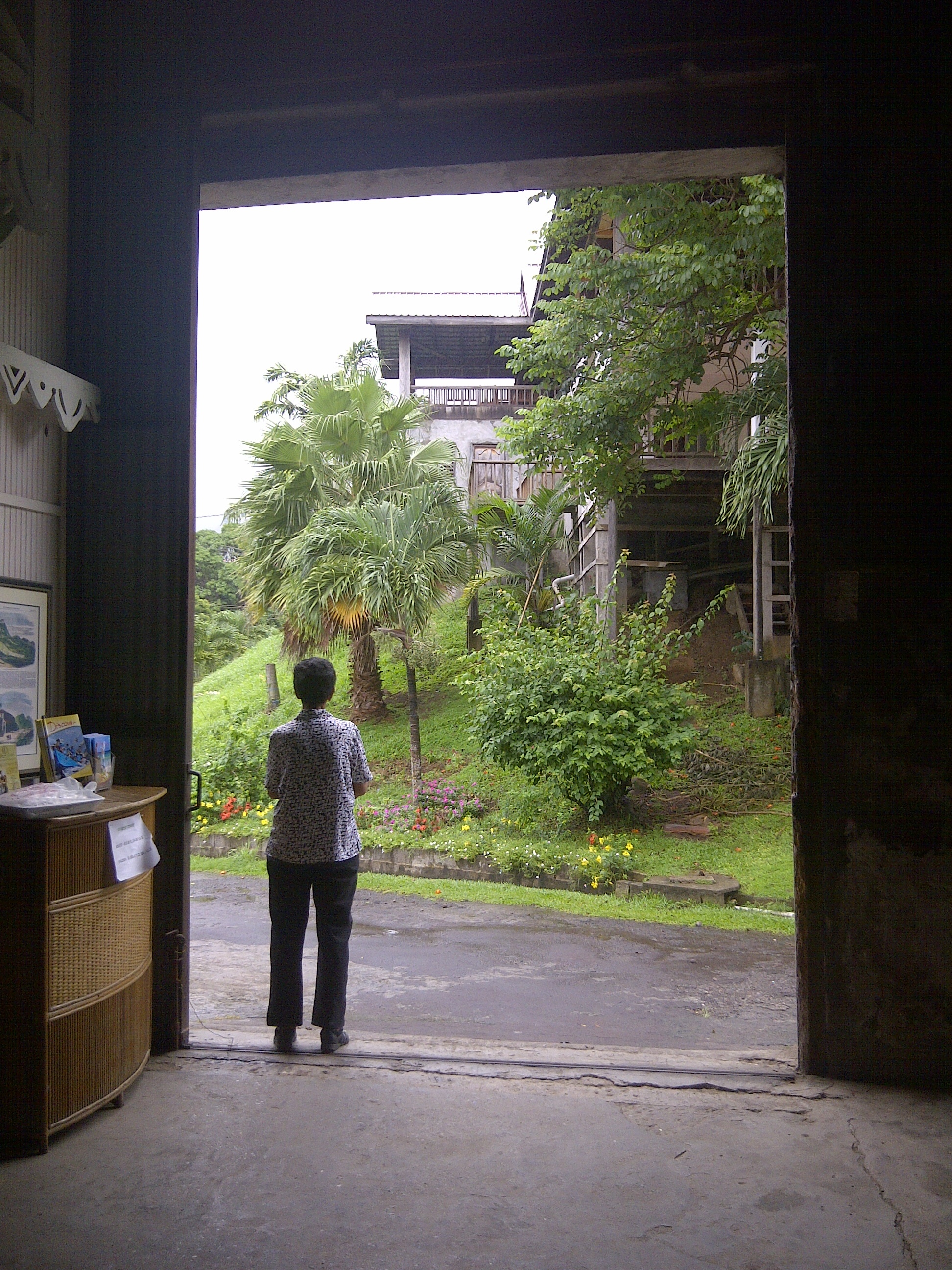
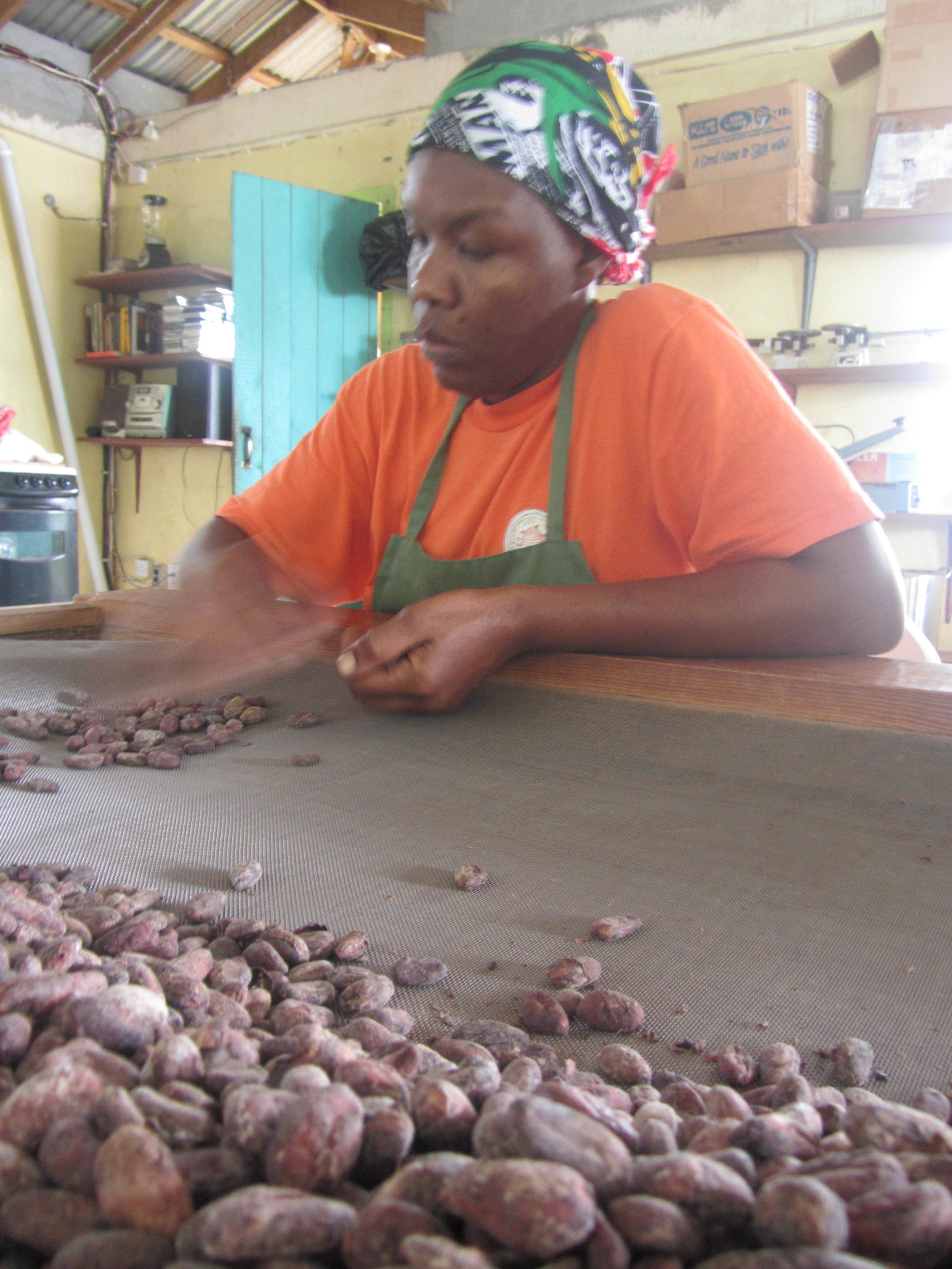
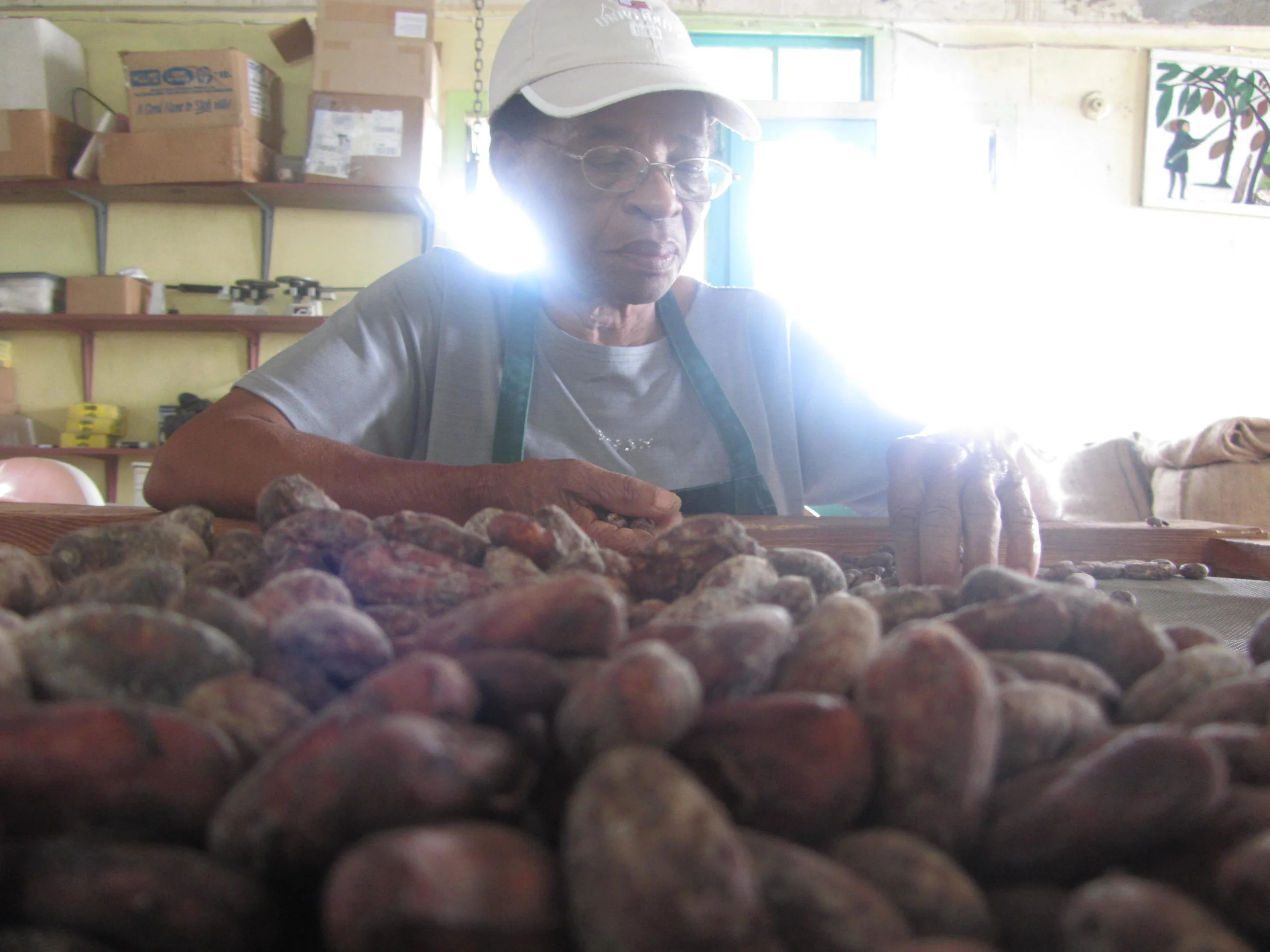



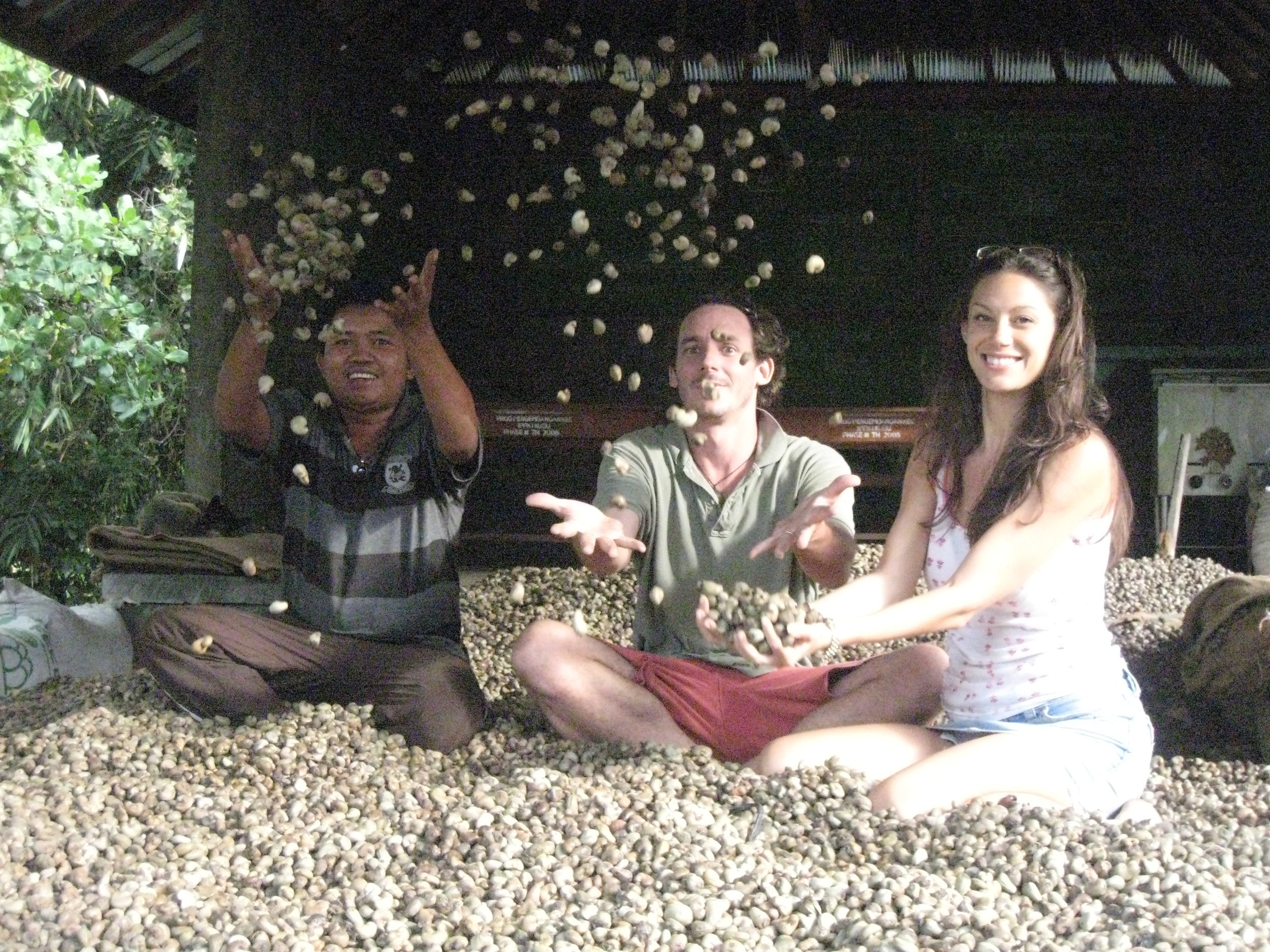
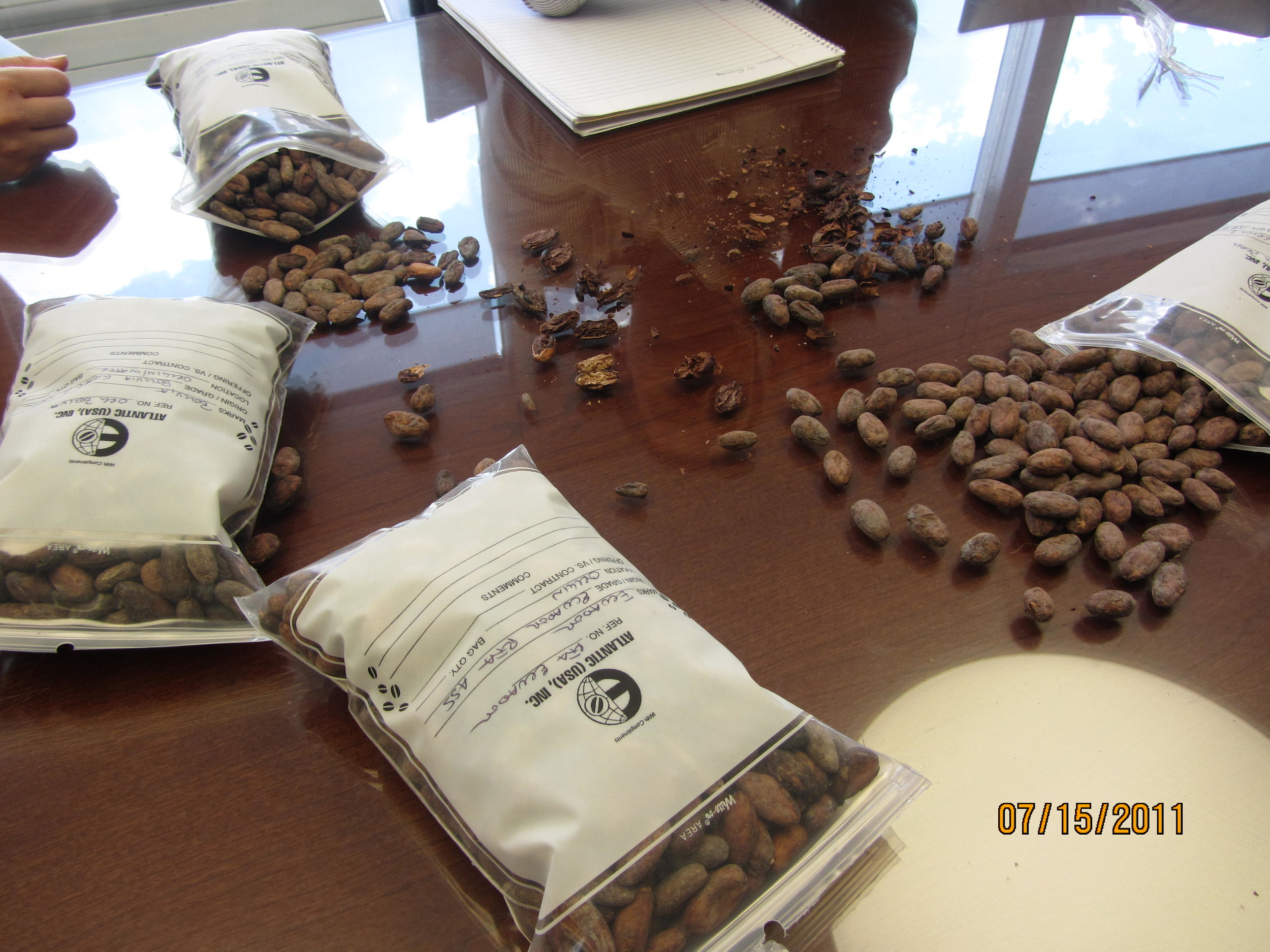
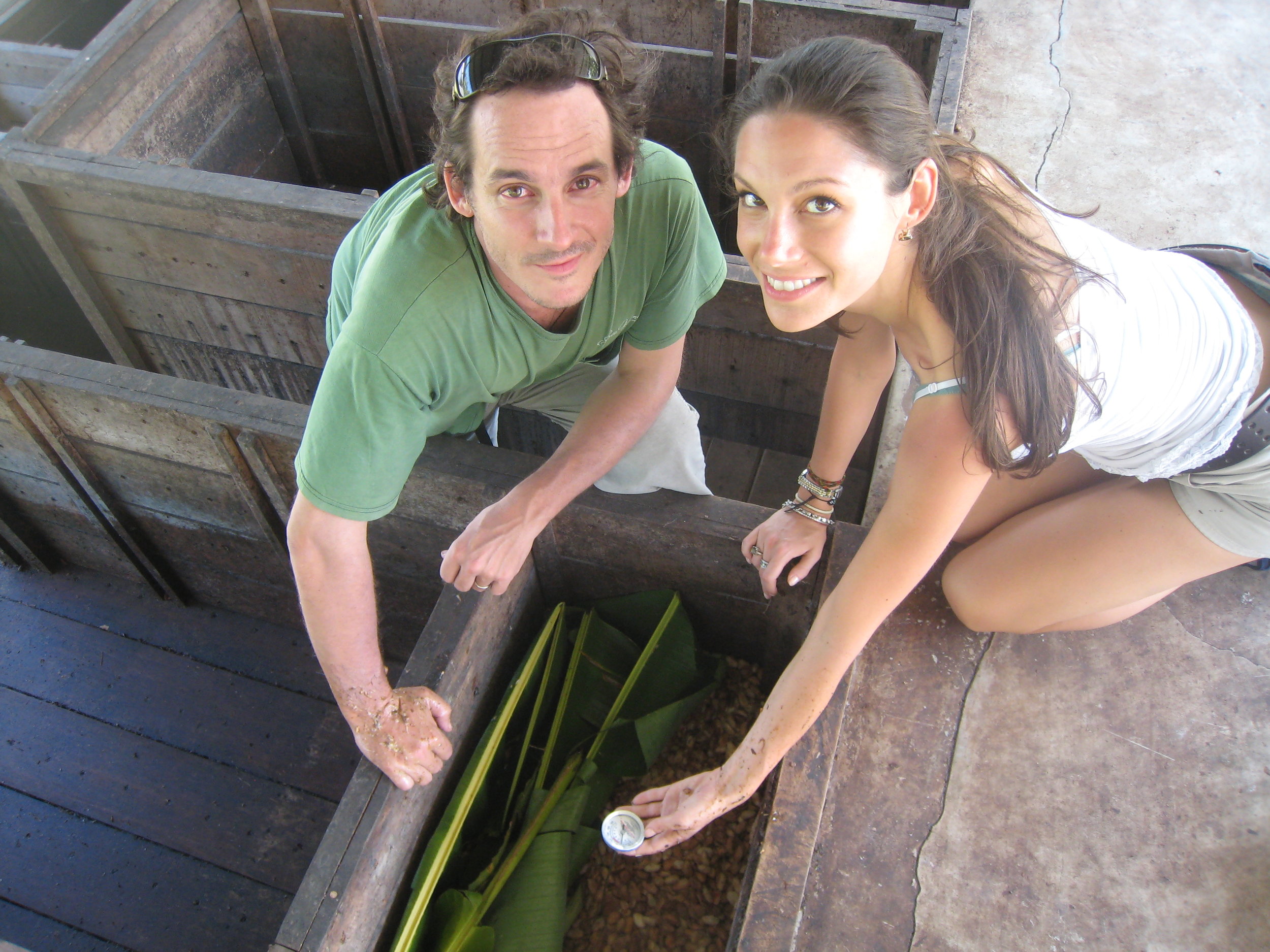
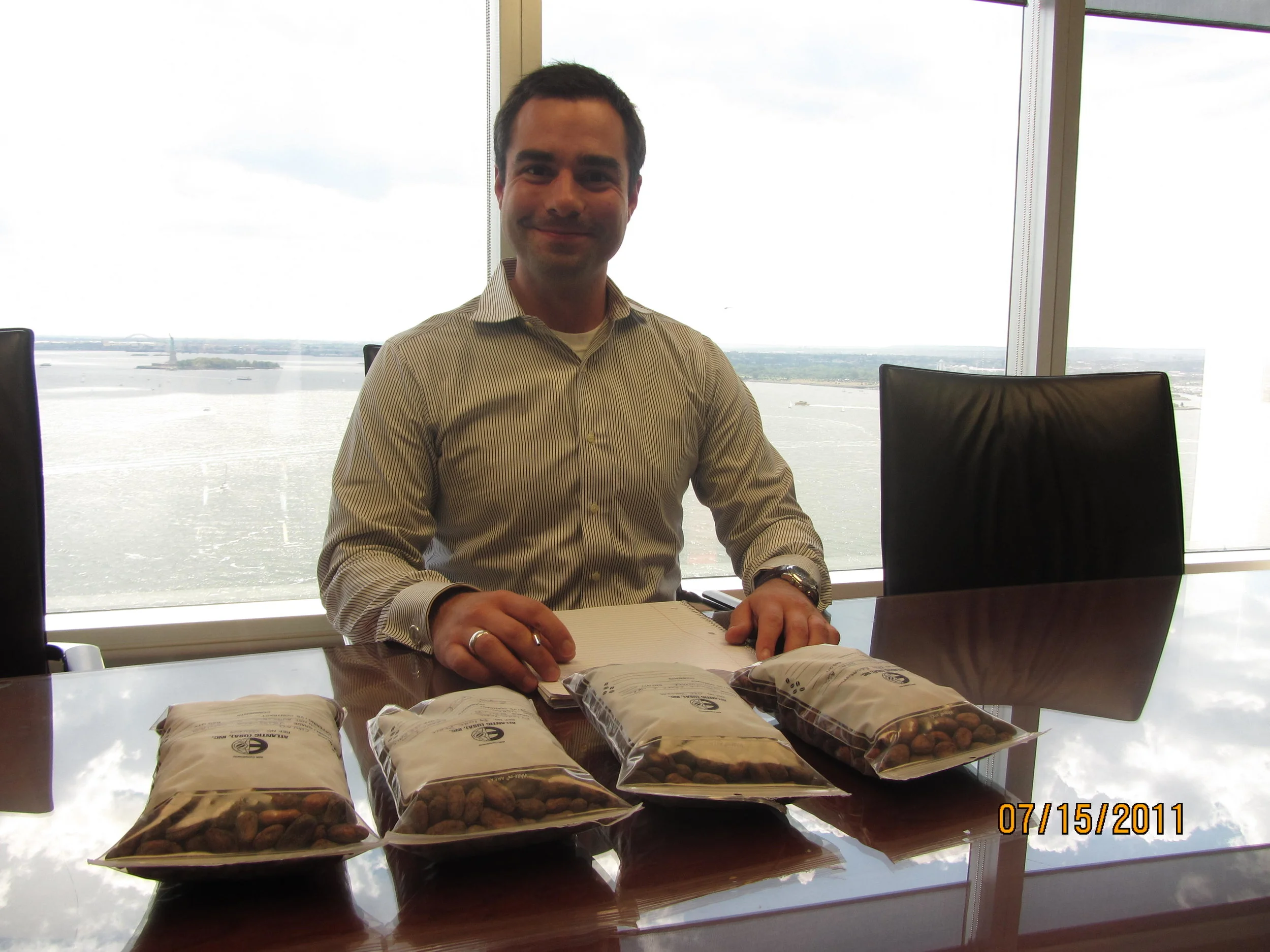

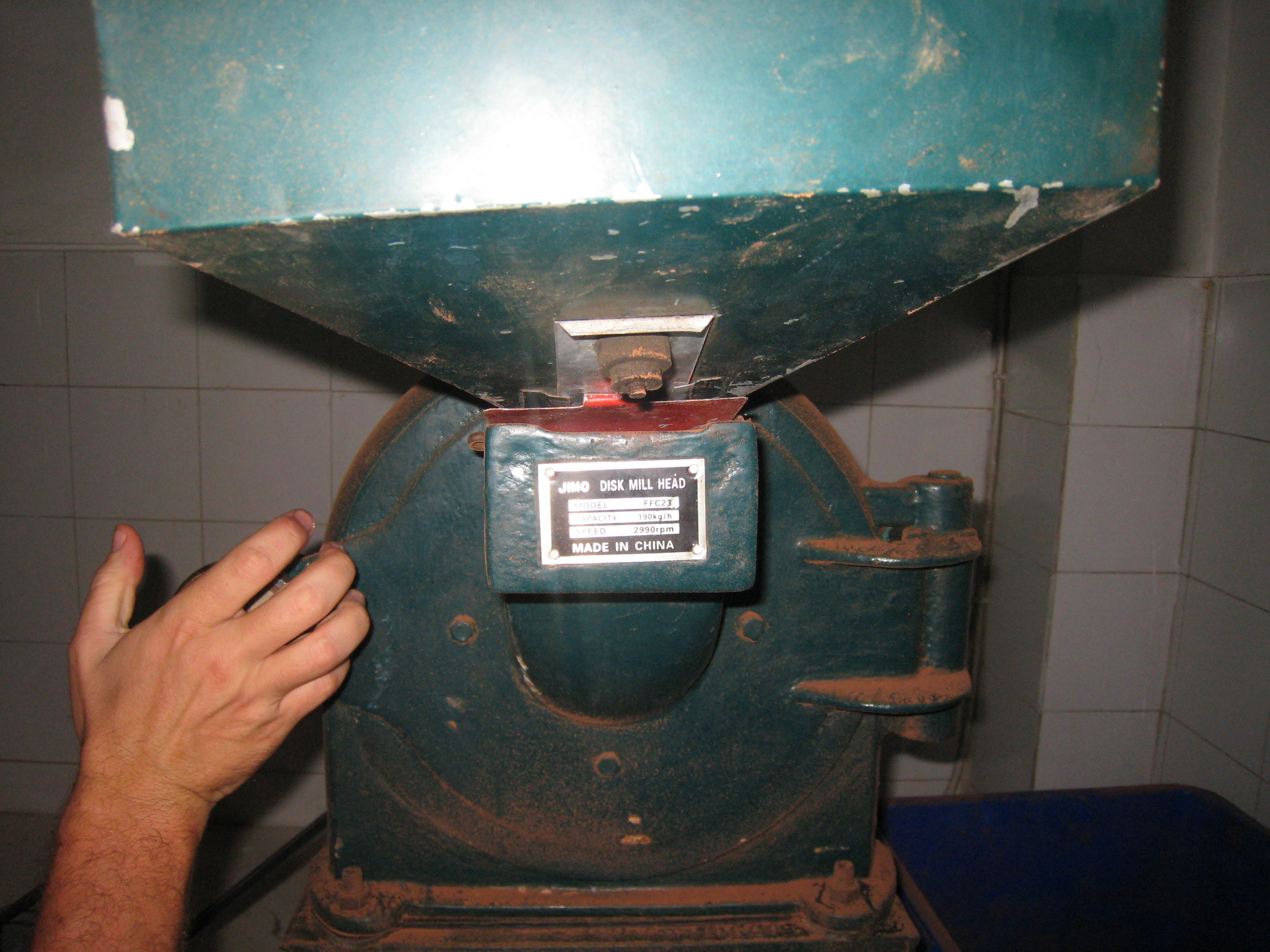
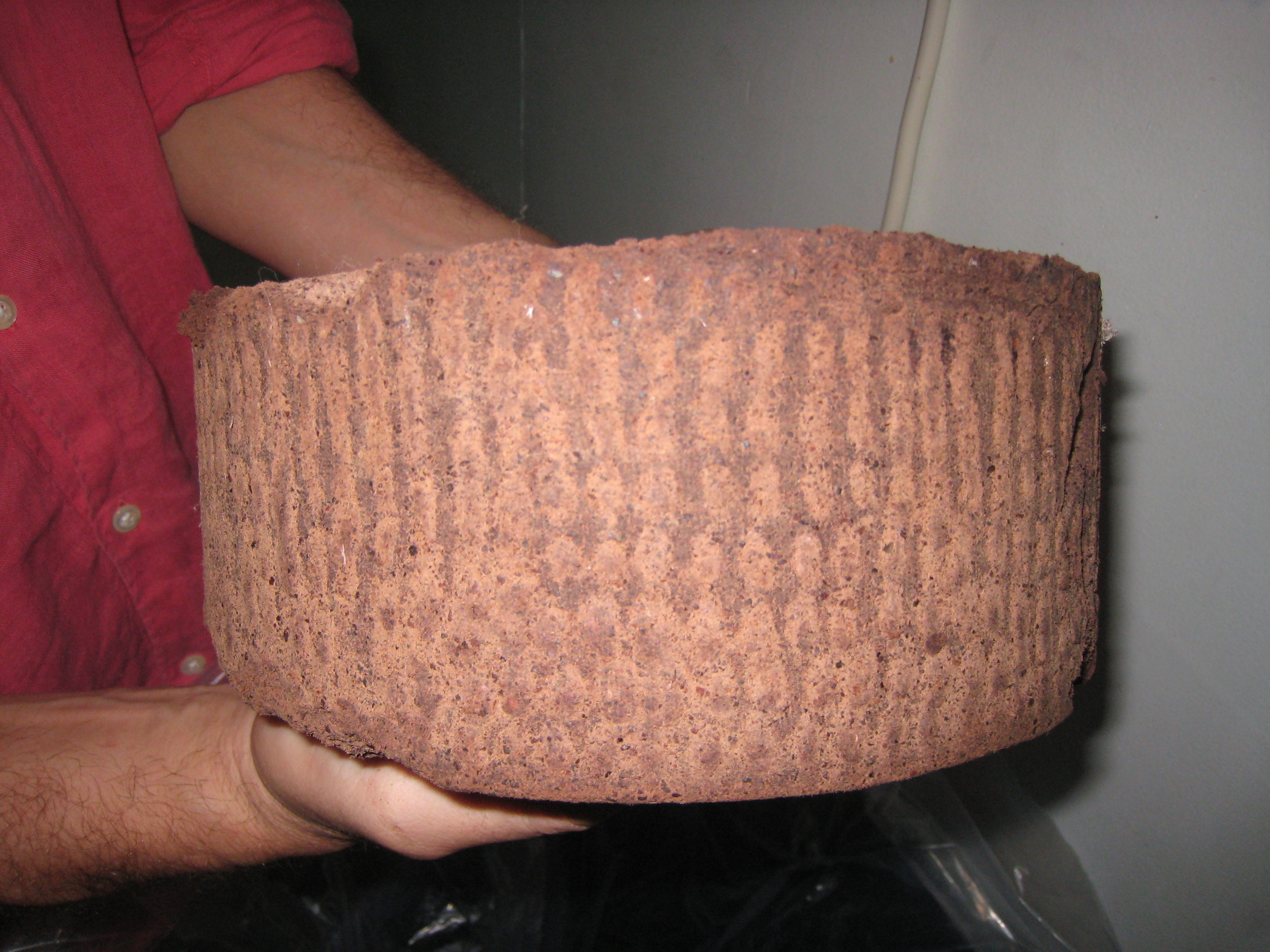
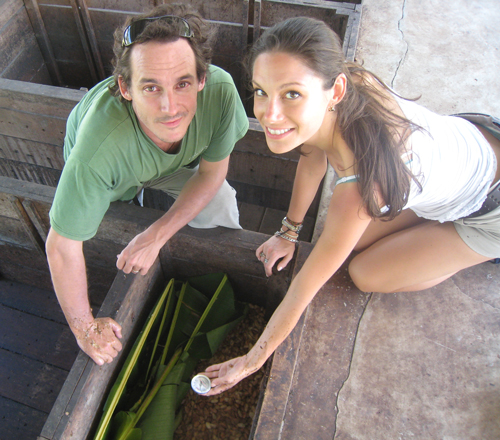
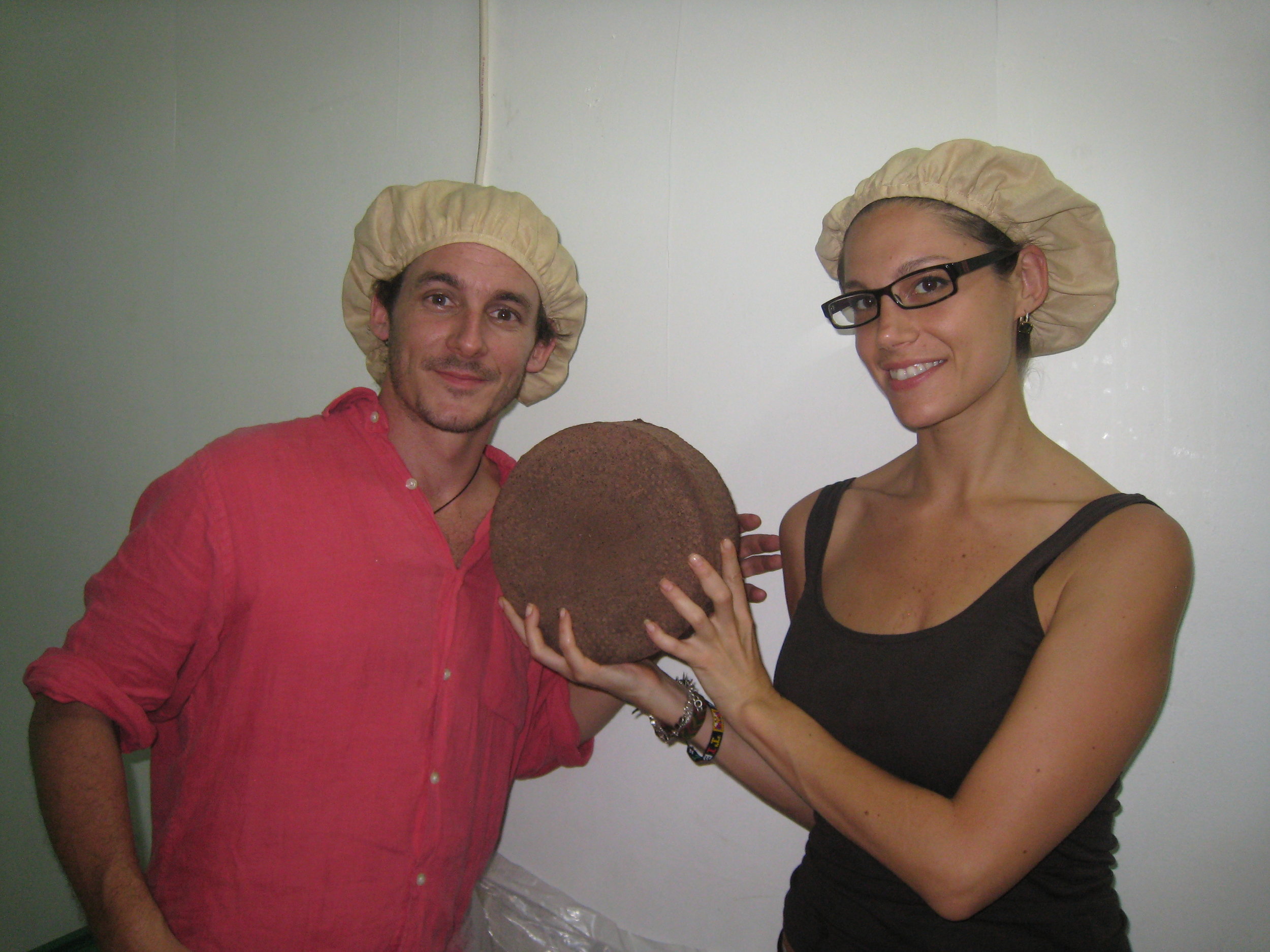
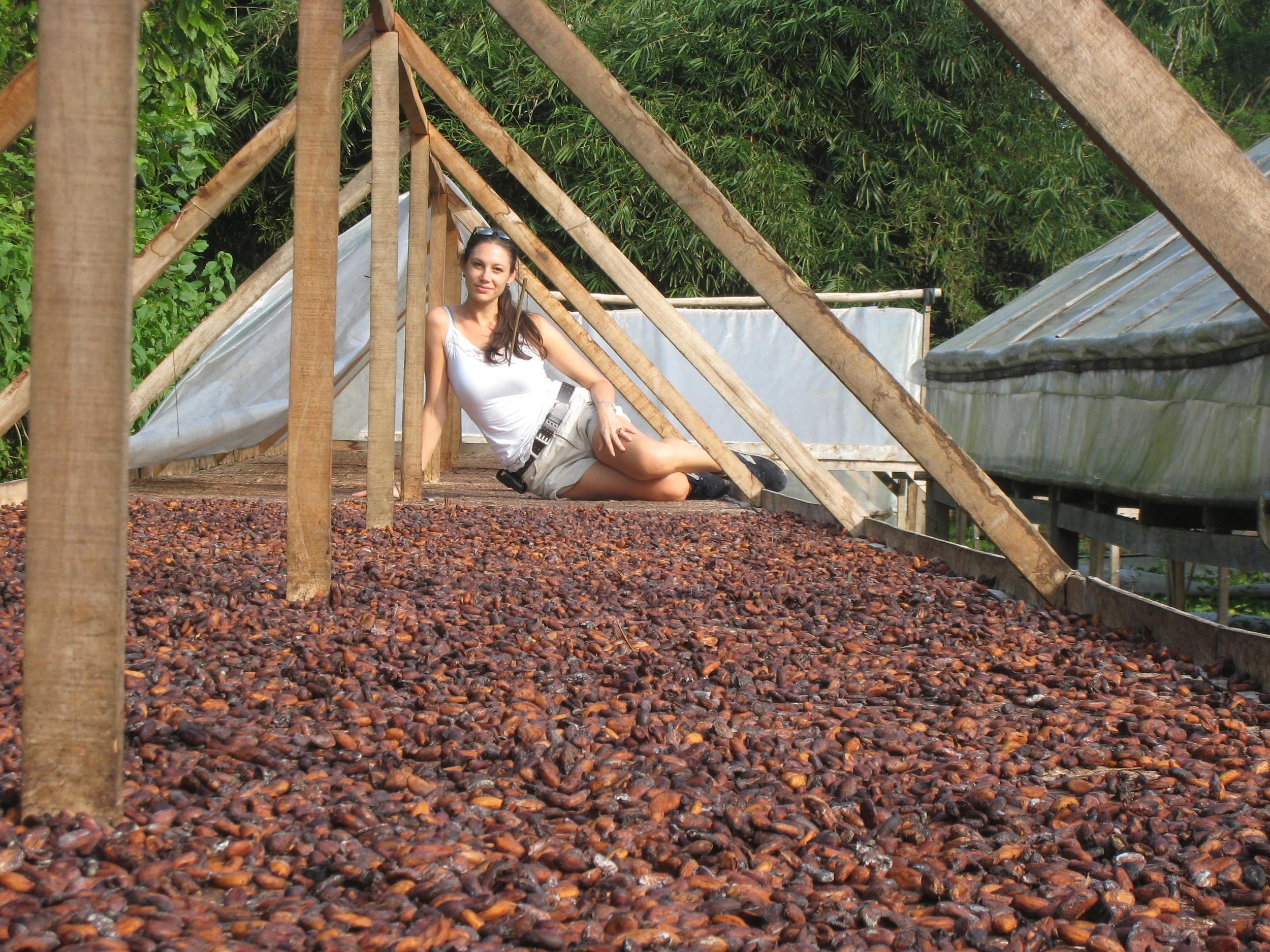
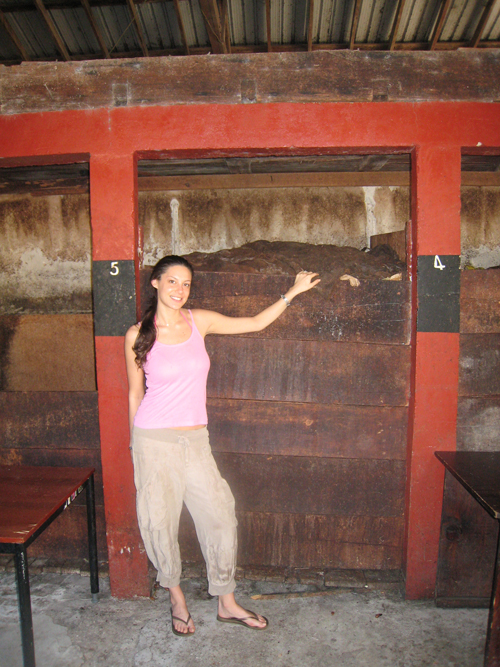
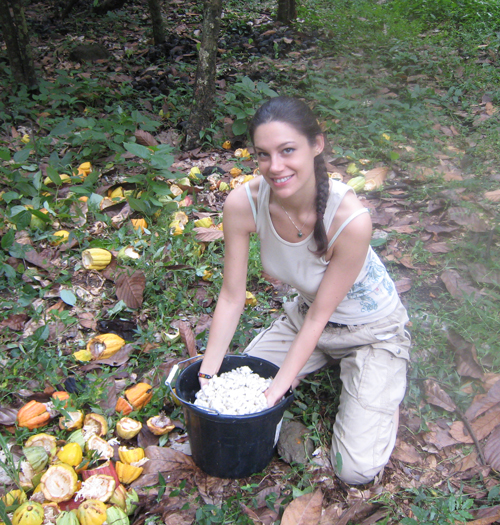
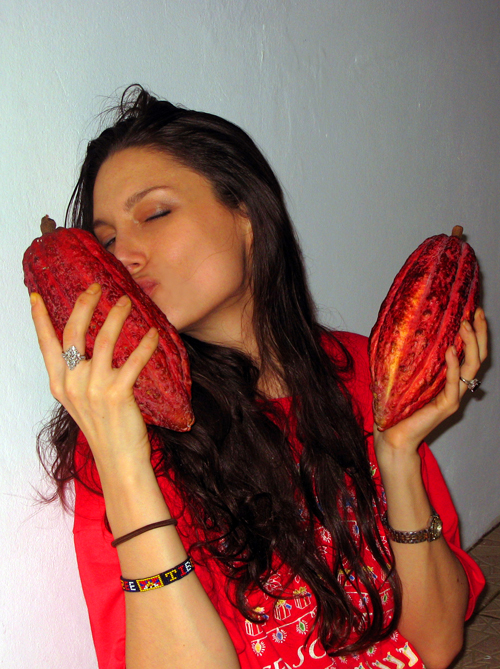
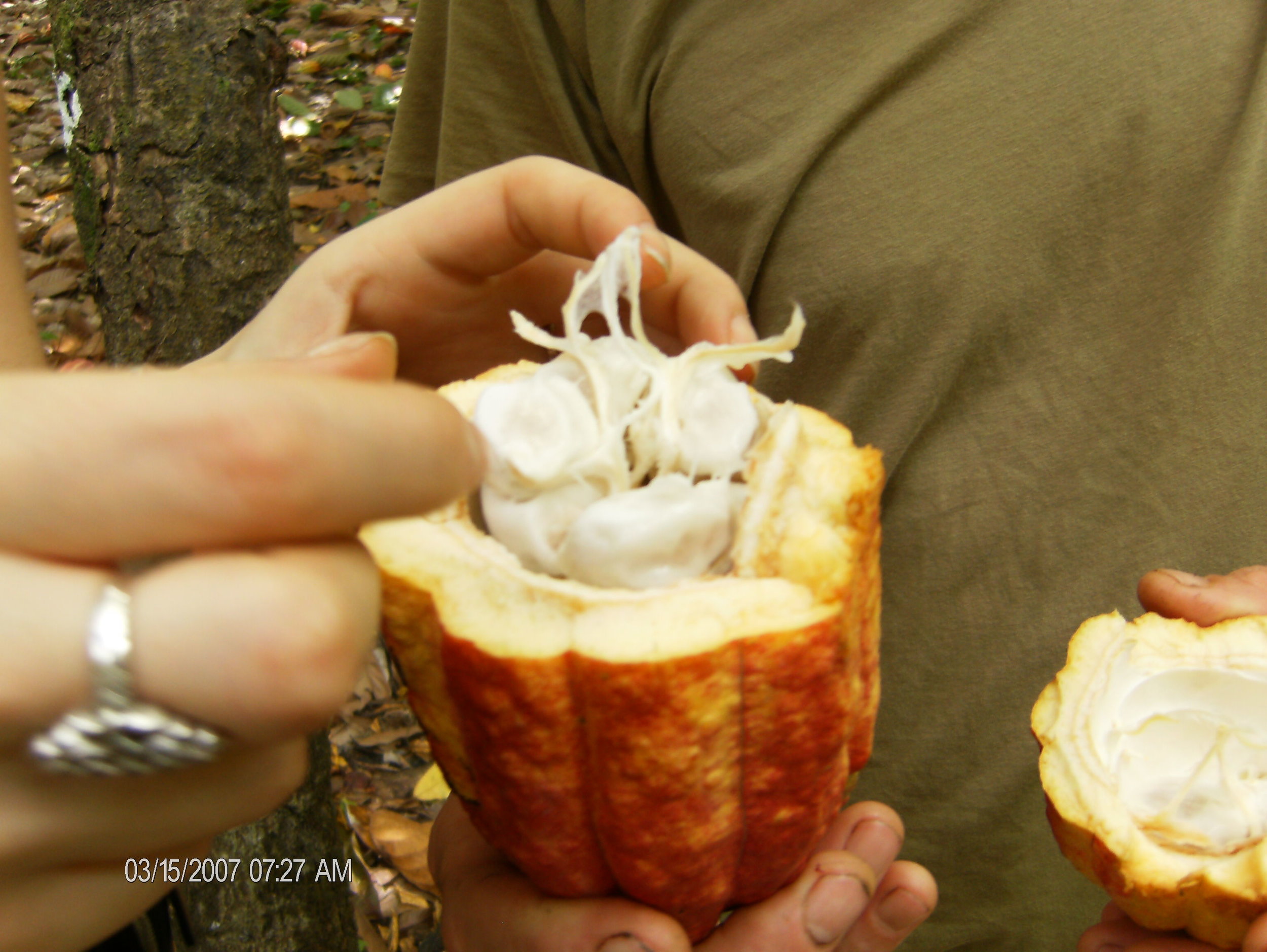
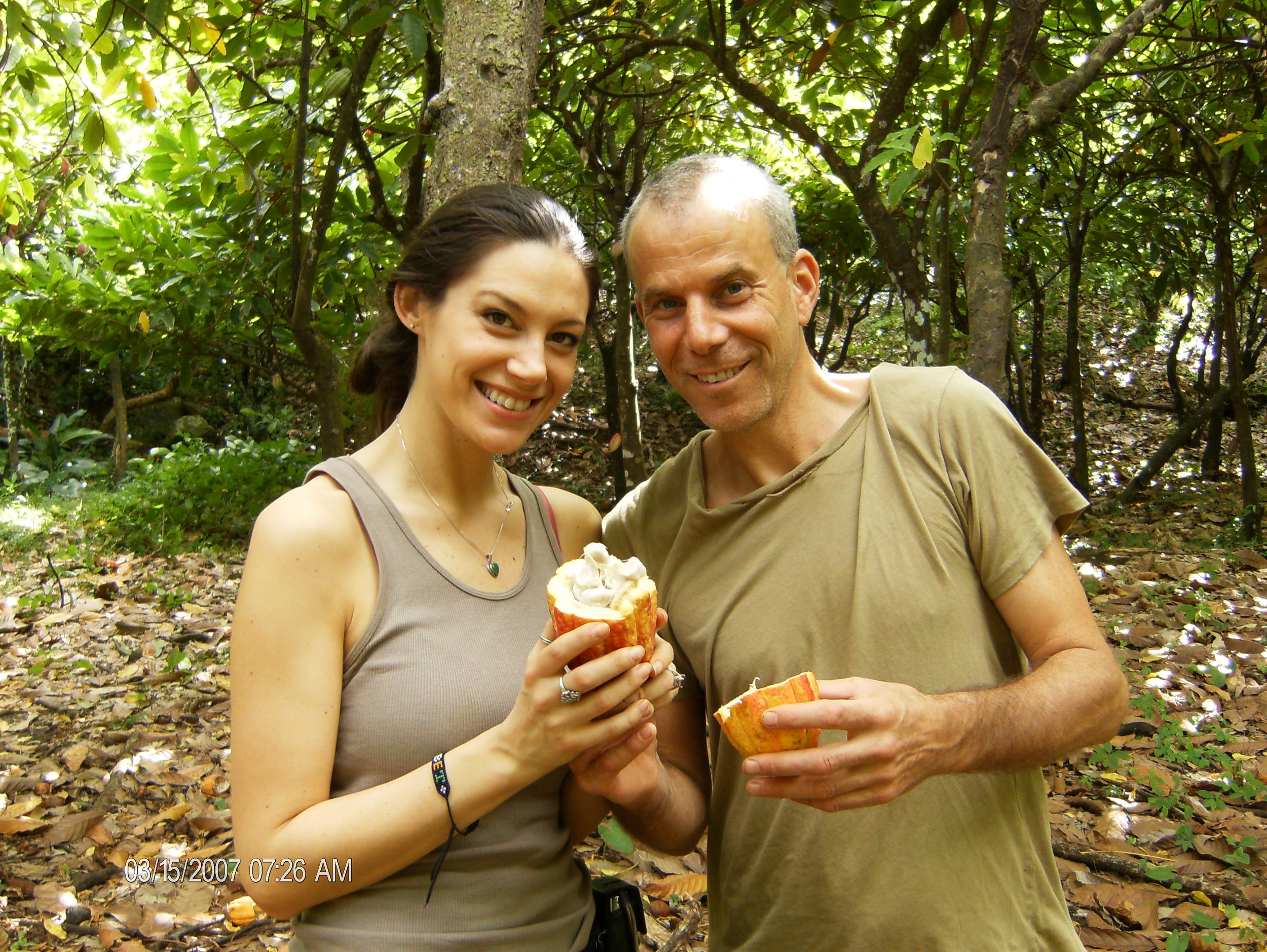
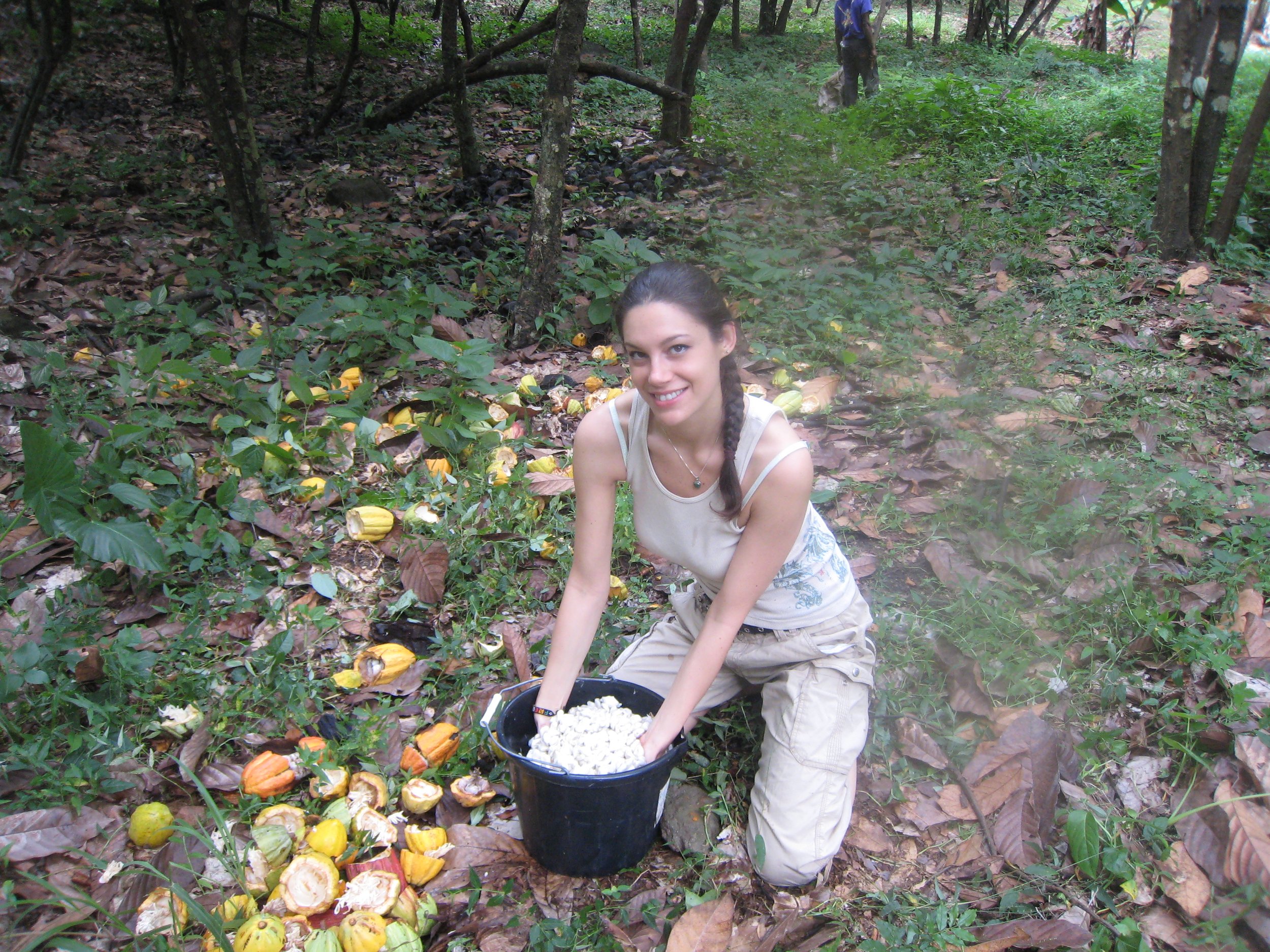
see Raw Integrity Blog for updates
January 24th, 2011
THE MAGIC OF CHOCOLATE
Falling in Love
Tasting my first cacao bean was Love at First Bite in a love affair clearly destined to last a lifetime. I encountered that first cacao bean while studying at the Institute for Integrative Nutrition, in New York. I learned that all chocolate comes from the beans within the fruit pod of an ancient species of tree called Theobroma Cacao. David Wolfe spoke of cacao as a superfood - a food whose extraordinary nutritional content has been used medicinally for millenia. I became intrigued by its mystery and magic and plunged into a study of its historical use and medicinal and psychological benefits.
Chocolate and Diet: Partners in Health
By including large amounts of raw, fresh, high nutrient foods in one's diet, an exclusion of empty calorie, highly processed, less fresh foods naturally occurs. In my own diet - and those of my clients and colleagues - increasing consumption of raw food has been the simplest and most sustainable way to establish equilibrium with regards to bioindividual nutritional needs. Even for short periods of time, adding a minimum of 70% of fresh produce and foods processed under 118 degrees to one's diet can help identify proper portion size, balance weight issues and hormones, identify underlying food allergies, decode and curb cravings, and most importantly, help a person learn to listen to their body and how their energy levels respond to certain foods.
The experiential knowledge of how it feels to eat a diet with no refined sugar, dairy, cholesterol, gluten, or soy is helpful even if an individual decides that the raw food diet is not appropriate for them long-term. I have seen that, after experiencing this new way of eating, people who begin to reintroduce cooked food into their diet do so with much greater consciousness of the quality and quantity of what they are eating, as well as how the food makes them feel. They are also able to adjust their own diet more intuitively to maximize energy without the assistance of a health counselor. Especially after eating a diet high in wheat, refined sugar, meat, and dairy, a dramatic change in diet to high nutrient, minimally processed foods helps to re-establish what is frequently a long-lost connection between food and the body. The consequence can be a feeling of greater health and the desire to work towards wellness in all areas of their life.
Why I Make Chocolate
As a Certified Holistic Health Counselor, my passion is helping people to enjoy the process of becoming healthier and living deeply fulfilling lives. In my practice, I have found that chocolate, as an extremely nourishing food on its own and as a carrier of added herbs and superfoods, can be a highly effective tool for improving health.
I started making chocolate to replace my clients' unhealthy sweet indulgences with the most nourishing chocolate bar I could create. Not only did the chocolate replace their less healthy sugary foods, but it also catalyzed other changes in their diets. When a person realizes that a commitment to health doesn't need to mean sacrificing their favorite food, eating broccoli and avoiding a muffin becomes a lot more do-able, because s/he can still indulge in healthy chocolate. And that ability to indulge in something decadent while fortifying their health inspired passion for the added herbs and super foods - catalyzing further supplementation and diet modification. My clients began to request that the chocolate be sold in stores, and our growth has been 100% through word of mouth.
An Ongoing Journey
Even after personally harvesting pods from trees; dehydrating, winnowing, grinding, and conching the beans; making tens of thousands of bars by hand; reading, researching, studying, attending seminars and conferences, and consulting with industry leaders, I am aware that so much remains to be learned. And making, packaging, and shipping a final product in environmentally sustainable, socially responsible ways is a constantly evolving process that I shall elaborate on in future Gnosis Project posts.
But in the center of this all, I find the Simplicity of 2 Truths: First, that cacao is a delicious medicine for the mind, body, and spirit. And, second, that by conducting all operations of my company with total integrity, our product will deliver our message to a community far beyond our direct customers. By choosing suppliers based not on price but on alignment with our values and standards, Gnosis means to support a larger movement towards higher quality food, a more sustainable model for food production, and a more conscious model for business. These truths are embedded deep in my heart.
THE RAW FOODS MARKET: A BRIEF OVERVIEW
A New Sector
Though fresh produce is obviously not new on the market, and so many of the superfoods which make up the raw food industry have been eaten for thousands of years by indigenous cultures, packaged raw foods are a very new and increasingly visible phenomena. Whole Foods Market, for example, has created raw food sections in every region and has incorporated superfoods into their Whole Body department. Restaurants, cafes, and health food stores offering exclusively raw food items are opening throughout the US and internationally, and many other restaurants and markets are beginning to offer raw items in addition to their conventionally cooked lines. Online raw food retailers are growing in number, visibility, and diversity. There are a multitude of raw crackers, cookies, nut cheeses, trail mixes, superfoods, drink mixes, and chocolates.
New companies and products are appearing by the dozens. When I first started eating a raw food diet in 2006 I could not find any raw chocolate bars or truffles in New York City; now, there are four NYC based companies. With over 30 companies in the US - and more abroad - focusing exclusively on raw chocolate products, raw chocolate is now becoming a permanent niche in the multi-billion dollar global chocolate industry.
Raw Foods and our Future
The dramatic growth of the number and availability of prepared raw food products is a powerful and encouraging indication of the future of food. Instead of only searching for a remedy to our current health crisis, people who choose raw foods are looking beyond symptoms to the root cause of illnesses in an effort to both treat and prevent them. There are hundreds of health clinics, retreat centers, and holistic counseling practices in the US alone, that are dedicated to helping individuals include more raw foods in their diet.
Their existence is proof of the increasing understanding of the fundamental role that diet plays in the treatment and prevention of such major diseases as cardiovascular disease, diabetes, obesity, depression, gastrointestinal diseases, and so many more. Even the quickest of internet searches will identify hundreds of success stories written of lives that have been dramatically improved - in some cases saved - by eating a raw food diet.
There are also clear benefits to raw foods beyond improving diet. Raw foods are minimally processed (certainly less processed than a product's conventionally cooked counterpart) which results in less energy used, by-products, packaging and other wastes. There also appears to be a strong connection between raw foodists seeking food closer to its natural state and a concern for our planet's soil, water, and air. Raw food enthusiasts are frequently, more aware of environmental concerns as they are on the lookout for local, organic, and biodynamic foods, and are more likely to reuse, recycle, and use alternative methods of energy.
The health and environmental crises will only be solved when our collective individual efforts, including voting with our dollars, force the food industry and regulatory agencies to educate consumers about preventative strategies, raise standards for what is considered safe for consumption; and fill shelves with products that prioritize health, well-being, and sustainability over sweetness and low price. I really believe it is a partnership between farmers, manufacturers, suppliers, and consumers that will ultimately lead to a healthier society and planet.
THE ISSUE AT HAND
Recently, a distributor of chocolate products labeled "Raw" discovered that its supplier had been selling conventionally processed cocoa to them as raw cacao. This distributor, Essential Living Foods, is committed to transparency and honesty, and therefore brought this to the public's attention. As a result, the issue of "How can we know this is raw?" is coming under increased scrutiny.
The Organic Movement: Establishing the Path to Integrity
The issue at hand carries a powerful - and positive - message: the raw movement is now so substantial that it has begun to parallel the developmental path taken by the organic movement almost a century ago. During the early years of organic farming, most products were consumed locally; consumers were in direct contact with growers, or had confidence in retailers who purchased products directly from growers they trusted. Freshness and direct supply, along with no chemicals, characterized organic production. In the 1970s, the supply chain lengthened as demand for organic products grew; products passed through more hands and traveled more miles. As a result, consumers wanted guarantees that the products they bought were truly organic, and growers needed a way of proving they were. This is where the raw food movement is now.
The solution was to implement a third-party certification of organic products' integrity, and, by the late 1980s, a number of private and state-run certifying bodies were active. However, inconsistent certification standards and well-publicized instances of fraud led the organic community to pursue federal legislation. The result was the Organic Foods Production Act of 1990, which mandated the creation of the National Organic Program (NOP) and the passage of uniform organic standards. These standards are now incorporated in the National Organic Program Regulations, which can be found on the NOP Web site. Implementation of the Regulations began on April 21, 2001. Through accreditation, the NOP implements its regulations through certifying agentswho use the National Standard. (Source: Kuepper, George (2002) “Organic Farm Certification & the National Organic Program.” National Sustainable Agricultural Information Service.)
There are still many important issues to be addressed by the NOP: foods are excluded that grow in the wild and on farms that lack the funds to become certified. The current certification dynamic puts organic farmers and manufacturers at a disadvantage because organic farming is inherently more expensive - it requires more labor intensive methods of pest control, for example, and the yield of an organic crop is lower than that of a conventionally grown one. A very important question must be addressed : whether it is the farmers whose costs are already increased who should to pay for certification, or whether the farms using chemicals to reduce cost should be the ones in need of certification with organic farms required only to send in samples for analysis.
Systems must evolve with the processes they facilitate, and the responsibility is shared by everyone - on both the industry and consumer side.
The Raw Movement: Evolving in the Same Direction
Consumers of organic products in the 1970s voiced the same concern that consumers of raw products are voicing today: "How can we be sure these products are truly raw?" As was the case with organic produce at this stage, there is currently no certification for the processing temperatures, nor is there a known testing method such as pesticide residue to ascertain processing temperature from the final product. Thus it is easy for an item which has been subjected to high heat to pass on the market as "Raw."
Keeping low temperatures is not only out of normal production routine, but is also more labor intensive, time-consuming, and thus more expensive. In this context, we can easily understand why specifications were not followed in the case of Essential Living Food's Ecuadorian supplier: there was no one on site directly overseeing the operation who was committed to Raw. It would be so amazing to just trust that we can distinguish amongst the companies and products, but even with the best of intentions a company may unknowingly mislead their customers unless they have the motivation and resources to perform due diligence - performing such extra research and, most importantly - physically visiting farms and facilities.
WHAT GNOSIS CHOCOLATE IS DOING
What does Gnosis Chocolate do to ensure our ingredients are Raw, Organic, and of the highest quality? When I began making chocolate, I grilled my suppliers and peers with questions and made my raw, vegan, organic, specifications crystal clear. As my knowledge of ingredients and processes grows, I regularly return to my suppliers with increasingly in-depth questions, and I continue to work with industry leaders to develop new and ever more effective ways to assure raw integrity. All distributors from whom I have purchased cacao (in the form of paste, butter, or powder) in the last year-and-a-half have confirmed in writing that none have been heated past 118 degrees.
In April of 2009, I decided to do my own analysis. Together with an internationally-recognized chocolate expert, I analyzed the appearance and flavor profile of all the raw cacao paste, powder, and butter that was currently available to determine which were - or were not - Raw; I continued using only those which were not in the least questionable. But so many any factors influence flavor, color and smell of cacao that there is no real way to judge the processing temperature from the final product - so I decided to travel to the heart of the matter.
The following October, after the Salon du Chocolat Professionel in Paris, I commissioned a chocolate factory near Lyons to produce paste that I could personally certify was raw, since I would participate with my hands and eyes in every step. This factory is owned and operated by a third-generation family business that produces some of the world's highest quality chocolate. My intense personal involvement made it possible to compare what I was making with what other sources were supplying, to determine the variety, quality, and origin of the beans used, and to watch the temperature guages.
Although I had produced chocolate from the bean on small scale machinery, it was important for me to turn cacao bean to paste on large scale equipment. Since my sources are more likely to use such larger equipment, this would elimate the only remaining variable. I chose cacao beans that were certified organic: fermented and dried under 118 degrees. Then I personally dehydrated the beans in a conventional chocolate roaster and charted the temperature every sixty seconds to verify raw integrity. A winnower then cracked the beans into little pieces (nibs) without heat. We then put the nibs into a conventional chocolate grinder and watched the thermostat to confirm that it never reached 118 degrees. The result was a paste that I can personally attest has Raw Integrity. These beans are featured in our Grenada bar - part of our OrigiNib Collection which are now available! I will continue to share my experiences and collaboration with Mott at RawGrenadaProject.com
In December 2009, I traveled to Mott Green's Grenada Chocolate Company (GCC), where organic cacao beans are grown, processed, and made into chocolate - all on the same small island. The purpose of this visit was to experience first hand the entire process starting from the farm. I worked side-by-side with the farmhands as we picked cacao pods from the trees, removed the fresh beans from the pods, carted them up and down hills, and dried and fermented the beans. It's at that point that the beams are ready to be processed into bars.
Since Mott's GCC is a model of transparency and integrity, I also had the opportunity to learn about the struggles and triumphs of organic farming; operating a company as a cooperative of farmers that ensures social responsible treatment; and running a chocolate factory on solar energy. We repeated the same process of low heat dehydrating with Mott's beans and machines and I personally measured the temperature of the beans the whole time they were in the roaster to ensure that raw temperature standards were maintained. These beans are featured in our Madagascar bar - part of our OrigiNib Collection which are now available!
It would appear ideal for every chocolate maker to own his or her own farm and bean to bar processing machinery. But it would also be a massive waste of resources. If there are trusted sources who are able to verify their raw integrity, operate with consciousness of environmental sustainability, and who are able to customize the process for their customers' specifications, then incredible amounts of shipping damages to the environment, obscene financial investment, and extraneous work can be saved by having these sources focus their efforts on the perfection of this process while chocolate makers focus on bringing chocolate to the shelf. As always, the responsibility is shared in demanding high quality and standards, and doing due diligence to ensure those standards are not only maintained, but that they evolve with improvements to what is possible and changes in what is needed.
I will continue to visit farms and facilities and bend every effort to verify that my specifications are followed to the letter because nutritional and environmental integrity is the foundation of Gnosis. I would never put a product on a shelf that didn't embody these core values or mislead the reader of my labeling.
THE OPPORTUNITY
Misrepresenting facts is never a cause for celebration, but the intensity of the raw community's reaction to these recent events most certainly is. It communicates the strong demand for pure, healthy food, and a concern for honesty in labeling. We should, therefore, understand this reaction as an indicator of the raw food movement's dramatic growth and even greater potential.
This reaction parallels that of the organic community decades ago when similar challenges arose. The consumer activism that developed resulted in legislation and procedures designed to the enactment of measures (described above) to increase integrity and transparency. And, thanks to our organic predecessors, we have a blueprint for action.
We are most fortunate that there are those among us who will follow the organic pioneers' example and undertake the task of getting legislation drafted, passed, and enforced. They'll need our active and steady support as they work to: 1) Develop an auditable third-party world certification structure to ensure raw processing integrity and product traceability; 2) Maintain quality, vibrancy, and integrity in the raw food supply chain as demand for raw food increases; 3) Explore and research the specifics of raw food production and the associated temperature benefits of each food type (for example, the maximum temperature that one should subject lettuce to might be much lower than that of nuts, and; 4) Develop further testing on the nutritional benefits of raw vs. cooked food.
The Higher Path: Faith in the Process
As we follow purity-related developments, let's remember that the developmental process of all things is an unending cycle of growth, challenge, increased consciousness, and renewed growth. We see this in ourselves; it's the bumps and challenges that frequently stimulate our most beneficial growth. We also see this process in the world, and accept the recall of cars, dolls, electronics, foods, and more as a matter of course. And we are thankful that someone is watching out for us. Let's understand this process, therefore, from the same perspective that allows us to travel in cars, planes, boats, and bicycles made by unseen hands - the perspective of faith. It is faith - frequently unconscious - that permits us to trust our homes will not collapse on us, the sidewalks and streets will not give way, and our clothes will not suddenly disappear.
Here is an opportunity, then, to extend the faith and perspectives we apply automatically to all areas of our life...to include raw foods. Let's have the same trust that the challenges we're discussing are actually opportunities for our movement to grow and become finer. Let's embrace our responsibility as consumers to voice our concerns to merchants, suppliers, and their sources, and to insist that standards and legislation be created that will create that growth and refinement.
Thank you very much for your time, consideration, and action!
Yours in Health,
Vanessa Barg
P.S. I have posted this project as a blog forum to stimulate conversation on vital issues that affect us all. Please invite your friends and colleagues to join our discussion by forwarding the link.


